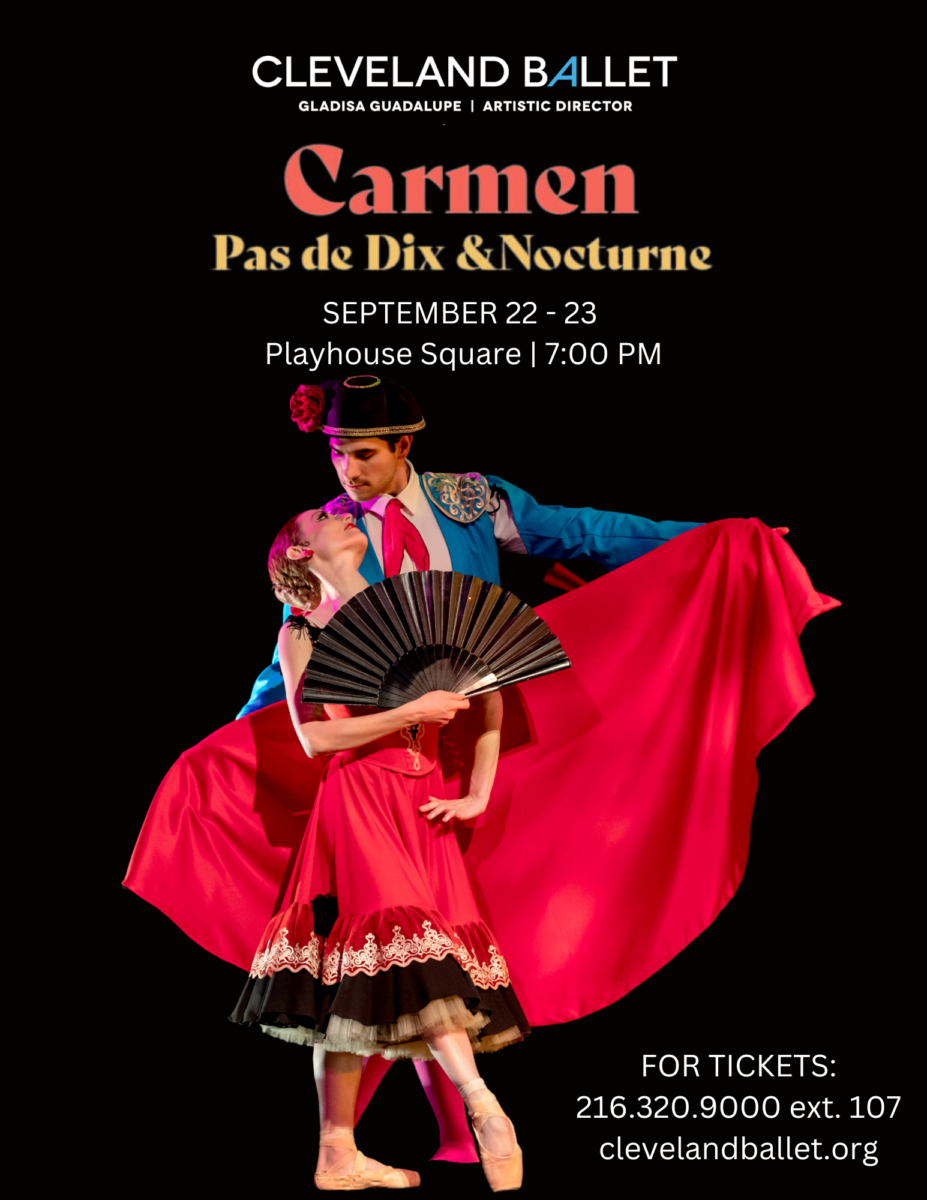This past weekend, the Cleveland Ballet performed its most recent show including “Pas de Dix,” “Nocturne” and “Carmen” at the Connor Palace in Playhouse Square. As it was our first time attending a ballet performance, not only were we enchanted by the performance, but it also reinforced our appreciation of the various cultural opportunities close to Case Western Reserve University. After receiving free tickets through the Baker-Nord Center for the Humanities, we were uncertain of what exactly to expect, but we thoroughly enjoyed the show, even if we were confused when we should take a bathroom break.
The founders of the Cleveland Ballet, Dr. Michael Krasnyansky and Gladisa Guadalupe, gave a brief introduction and history of the company alongside their own personal motivations for sustaining the company since its inception in 2014. Cleveland’s robust history of dance originated long before then; its roots date back to the beginning of the 20th century. Today, the company dedicates itself to cultivating and enriching the world-class performing arts sector of Cleveland. Guadalupe especially highlighted the company’s commitment to diversity, equity and inclusion.
“Carmen” follows the story of a young Spanish romani woman who works at a tobacco factory. After showing up late to work, Carmen gets into a fight with Manuela—the highest ranking worker—and ends up killing her. Don José, one of the guards who arrests Carmen, inadvertently falls in love with her. He releases her from jail and together, they embark on a brief, lustful honeymoon. Yet, soon afterward Carmen is attracted to another man, a bullfighter named Escamillo. Driven by anger, Don José confronts her about her duplicity and ultimately strangles her.
The company’s interpretation of “Carmen” is a shortened adaptation of a four-act French opera, but still included parts from the original score. Viewing the performance was phenomenal in and of itself, and yet, the most striking part to us was the on and off-stage musicians. The orchestra, playing from the confines of the pit, captivated the audience in a mesmerizing interpretation of iconic scores from each of the three acts. Even from the beginning of the performance, Guadalupe noted how the orchestra is a vital part of the show, explaining the expected appearance of both a pianist and guitarist on stage.
As for the music in the other two performances, “Pas de Dix” featured music solely from the orchestra, while the music in “Nocturne” came almost exclusively from a single piano player onstage. Both contained exquisite renditions of their original scores. We were pleasantly surprised by a beautiful cover of “Fantaisie-Impromptu” during “Nocturne.”
What we also loved and Guadalupe failed to mention were the two opera singers performing during the headline act, “Carmen.” Calmly stepping under the radiant spotlights, their emphatic vibratos soon rung throughout the theater, dazzling the audience with expressive interpretations of this sensual narrative.
The use of different kinds of musical talents created an incredibly cohesive and rousing show while also displaying the many artistic disciplines that thrive in such a multifaceted city as Cleveland. The show felt incredibly intimate, from the performance itself to the lovely introduction from the founders.
And that is not even considering the dancers themselves. On such a grand stage, their execution of each story—complete with synchronized spins and undulating twirls—created a reverberating effect in their aftermath. They truly bridged the gap between acrobatics and dance.
The dancers’ ability to express a story purely with their facial expressions was nothing short of incredible. It truly exhibited the unique ways in which someone can offer many possibilities for interpretation, yet maintain one singular narrative. In a way, ballet is a language in and of itself, communicating love, passion and the consequences of utter devotion.
The use of other visual effects to enhance the meaning of the show really resonated with us. During “Nocturne,” the lights in the background would change to reflect either a more somber or vitalizing mood, turning from gold to indigo. “Pas de Dix” had a lighthearted and cheery tone that was even playful at times. “Carmen” repeated a motif of burning crimson; its passionate hues were in all but one scene, where they descended into yet another indigo.
During “Carmen,” there were also many “interludes” in which the curtain fell, a small group of dancers danced in front of it, and once they were done, the raised curtain revealed an entirely new set of dancers, not unlike a theatrical production. This was complete with identifiable signage so that someone unable to follow the story could still get a sense of its progression. This made the show more dynamic and engaging, especially for an audience used to musical theater.
However, following the story was not necessarily straightforward, especially when considering the three acts altogether. Going into the show with little to no experience with ballet performances caught us both off guard, and we were left wondering about the relationship between the first two acts and the headliner. Were they three independent presentations that each enjoyed their time in the limelight, or did the show as a whole have a cohesive meaning? We also had some logistical concerns, like the aforementioned bathroom breaks.
But overall, the experience was nothing short of spectacular. From the lighthearted nature of “Pas de Dix” to the eloquence of “Nocturne” and finally, the bewitching performance of “Carmen,” we rate these performances a 10 out of 10.



